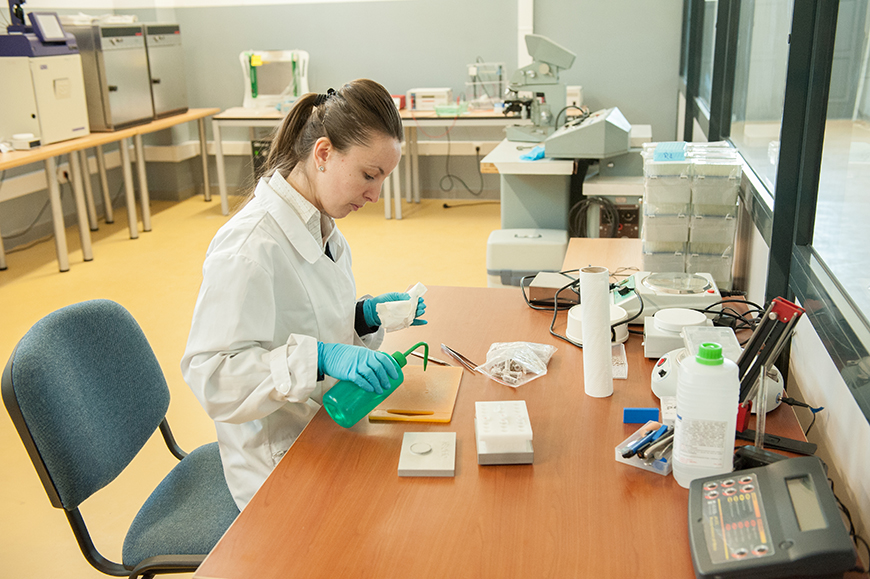Products and services with innovative potential
Forestland connectivity maps in Romania
(Developed within the framework of the project “COREHABS – Ecological corridors for habitats and species in Romania”, contract 6326/2015, Coordinator: Prof. Dr. Eng. Ioan Vasile Abrudan)
According to CORINE Land Cover 2012, in terms of land area and minimum width, the existing national forests were classified into 3 categories – Interconnection Nodes (IN), Nucleus Areas (NA), and Habitat Continuum (HC).
The categories were classified to guarantee living and reproduction conditions for tree populations in the short-term (50-499 individuals), medium-term (500-49,999 individuals), and respectively long-term (over 50,000 individuals). Subsequently, distances of 1,000 m, 1,500 m, 2,000 m, 4,000 m (Euclidian distance) were gradually used to assess forest connectivity at national level for the first time.

According to the connected land area categories, connectivity intensity and connectivity quality were also classified: strong, medium, and weak – depending on the connection with a HC, NA, and IN, respectively high, medium, and low depending on the total connected land area, as well as the origin of the component parts of the land area categories obtained by processing – IN, NA, HC. Furthermore, the information obtained from the Forest Vegetation Map of Romania (ICAS 1997) enabled the creation of the first connectivity map (5x5 km grid level) for the main tree species in Romania.
The results were published in Petru Tudor Stăncioiu, Mihai Daniel Niță, Gabriel Ervin Lazăr 2018. Forestland connectivity in Romania Implications for policy and management, Land Use Policy, online.
Innovative services
- assessment of the genetic diversity of forest species in relation to improvement strategies and forest management;
- genetics and molecular research of tree genomes by identifying DNA sequences;
- assessment of the genetic variability by means of DNA sequencing using molecular genetic markers and association with the valuable characteristics of tree populations in the national growing stock;
- identification of specific genes involved in the resistance to biotic and abiotic stress factors of trees;
- identification of valuable populations according to genetic criteria using primary biochemical and DNA markers with the aim of mapping them as genetic forest resources and marking the seed sources;
- analysis of the optimal, suboptimal, and restricted ecological niches for deciduous species with valuable wood (sycamore, Norway maple, rowan, cherry, common ash, black alder, etc.);
- identification and description of climatic and edaphic ecotypes for the main forest species in Romania (Norway spruce, silver fir, beech, oak), applicable in sustainable forest management and the conservation of vulnerable ecosystems;
- autecological, genetic, ecological, and quantitative genetics analyses to assess forest species behaviour in natural populations and experimental crops;
- soil analyses to determine the properties and content of nutritional elements;
- establishing ecological corridors at national, regional, and local level (by using modern techniques of spatial analysis);
- research related to interrupting seed dormancy;
- forest seeds quality control;
- estimation of carbon storage in plantations;
- consultancy in forest management certification: identifying forests of high conservation value, elaborating forestry procedures in accordance with the certification standard, etc;
- designing of silvicultural models for valuable deciduous species (common ash, sycamore, bird cherry);
- designing of silvicultural models (including cleaning operations, pruning, trimming) in young beech stands and mixed stands;
- establishing optimal techniques for applying pruning operations in pure stands and mixed stands with exotic North American species (black walnut, red oak);
- analytical and synthetic phytosociological studies;
- identification, description, and mapping of forest habitats of community importance;
- studies to assess conservation status and elaborating management plans for protected areas;
- studies on the dynamics of ecophysiological processes in stands, the dynamics of tree radial growth, mineral nutrition or the photoactive reaction of seedlings in natural regenerations;
- mapping and inventory of insect species in forest ecosystems with the aim of identifying those that might cause mass drying in various woody species;
- analysis of the risk of mass reproduction in bark beetles under various natural conditions, identifying the management measures for these populations with the aim to reduce the negative impact on ecosystems;
- identification of the mite and parasite species on Ips typographus adults;
- technical assistance for managers of state and private forests with the aim of preventing the increase in bark beetle populations;
- analysis of climate change scenarios and the possible effects on forest ecosystems in relation to adaptive strategies;
- determination of certain topoclimatic particularities at forest lot and sublot level based on complex digital models (sets of GIS thematic maps);
- modelling and simulation of hydrological and erosional processes in relation to silvicultural amelioration of degraded lands;
- study of the dynamics of wildlife populations;
- planning the intensive increase of hunting (hunting methods and techniques);
- guidelines for wildlife and habitat management, as well as salmonid management, in accordance with the biodiversity conservation and social-economic objectives;
- the complete assessment of conventional hunting trophies;
- conceiving guidelines for the efficient breeding of fresh-water fishes in semi-intensive and intensive systems, etc.




